Every three months, the Legislative Council comes out with a report saying that the state budget is in even worse shape than we thought it was. And with every report, we’re told how Legislative Council keeps missing because of the unprecedented speed and size of the change. Fortunately, we can go back and see how well the LC has done in the past. I don’t think I’ve seen the data presented this way before, but apologies if someone has done so.
The LC makes predictions up to 5 years out (although their latest report only goes through the FY2011-12), so here’s a rolling graph of the predictions of General Fund revenue (in $M) since March of 2000. The numbers are not net of TABOR, meaning they do not account for the TABOR limits, so it’s purely an estimate of gross revenues. The gaps represent reports that the LC has not posted on their site:
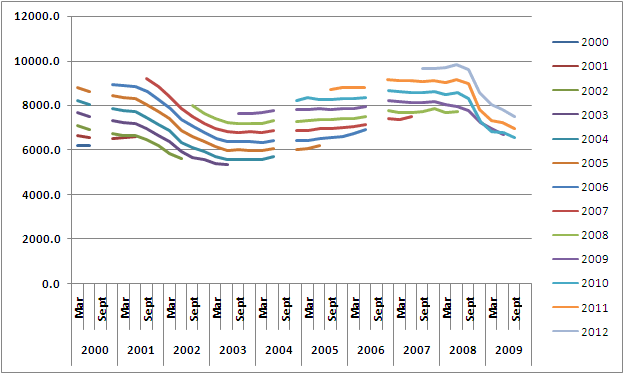
So the first thing you notice is that, no matter what the current conditions, LC almost always predicts a rising income curve even though that generally doesn’t reliably happen. In fact, it’s not just a rising income curve, it’s a almost always a constantly rising income curve. It looks like those pictures you used to draw in 1st grade, taking all the different-colored crayons or chalk or markers and running them along the page in unison. The current year estimates represent reality, but after that, LC assumes more robust growth rate that declines slightly towards Year 5.
Why? To put it simply, they have no idea what the actual economic growth rate is going to be, so they fake it. And it’s responsible for their consistent over-statement of future revenues throughout the decade.
The other thing you notice is that the recession of 2001-2002 took a pretty hefty toll on state revenues, and that it caught the LC completely by surprise. If it hadn’t, they wouldn’t have had to adjust their predictions so radically. In fact, the decline in dollar amounts is pretty close to the decline in the 2007-2009 recession, although the falloff wasn’t as fast.
Another way of looking at this is on a percentage basis of the eventual revenue:
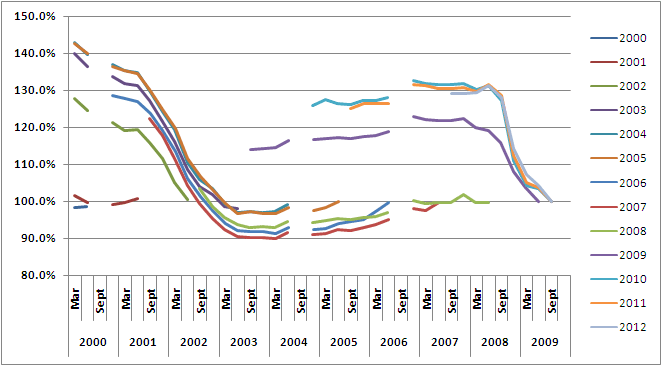
On this basis, the 2001 recession was every bit as bad – if not worse – for state revenues as the current one has been so far, it just took longer for the forecasts to fall. Remember, it was this recession, and the resulting drop in state revenues, that convinced the public to pass Referendum C. More on that in a moment.
The pattern of overestimating revenues and then mildly over-correcting is even more obvious if you synchronize the estimates at their endpoints. (The budget year ends in June, but the preliminary revenue numbers aren’t available until September, so 6 year projections stretch over 7 calendar years.)
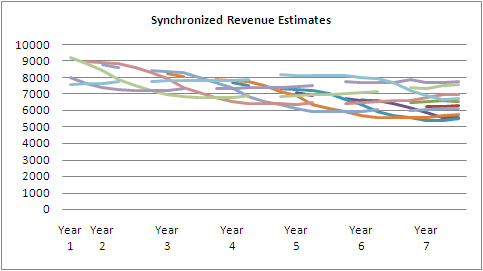
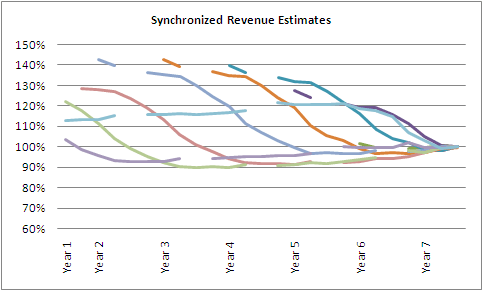
Some of this might be understandable if the secular trends were of declining revenues, but it hasn’t been:
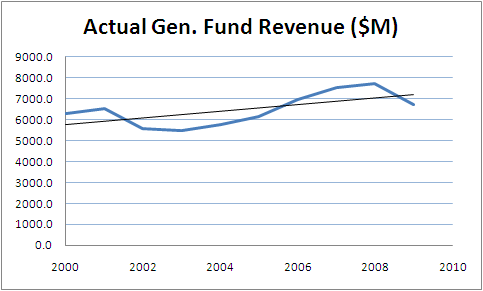
Which means that even in a era when the general trend has been upwards, the Legislative Council has overwhelmingly overestimated upcoming revenue. Again, this is almost certainly a result of using a plug-in number for economic growth during the out years. This is standard practice – we used to do something similar all the time when modeling companies’ top lines – but we weren’t responsible for their budgets. It clearly shows the dangers of actually relying on these predictions for budgeting and for policy-making. Certainly it contributed to the over-confidence that led to Amendment 23, and the same overconfidence that has led the legislature to spend every last non-existent dime of Referendum C monies.
Now about that. Proponents of TABOR, among whom I count myself, have often argued that TABOR’s limitations helped limit the damage from the 2001-2002 recession. Is this true? Well, probably, but it didn’t prevent the damage altogether, otherwise there would have been no cry for Referendum C. Nevertheless, by looking at the revenue estimates for one year, and comparing them with the TABOR-revenue estimates, we can see that the raw numbers varied much more than the TABOR-adjusted estimates. We use 2005 because it’s one year for which we have a full
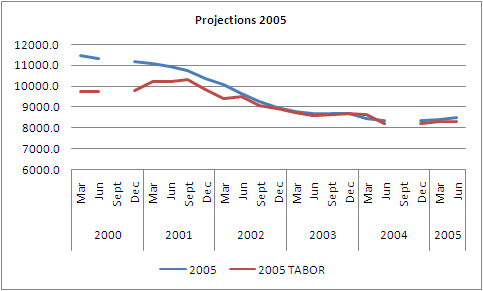
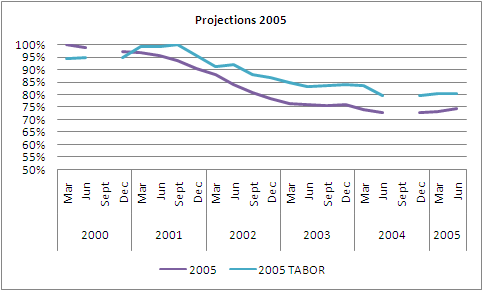
As you can seen, the raw revenue estimates fell to as low as 72% of the original estimate, finishing up at 75%, while the revenues including TABOR refunds stabilized at 80% of the original. Someone doing budgeting even a year out would have had to cut an additional 8% from programs had they used the raw numbers, as we do under Referendum C, compared to someone who had limited himself to TABOR-adjusted revenues. This isn’t exactly Armageddon, but it ain’t chicken feed, either. Given the howls of pain that come from even modest cuts in government programs, the 8% surely must be counted significant.
None of this is intended to beat up of Legislative Council. They’re being asked to do an impossible job, and appear to be doing it much better and with more integrity than the governor’s office is. But to repeat – it indicated the foolishness of relying on long-term estimates for actual budgeting, and makes a case for the sort of conservatism that TABOR forces upon the legislature.



